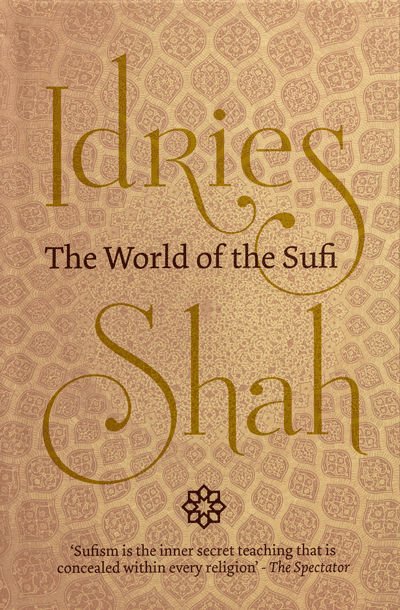A comprehensive collection of authoritative and fascinating essays, assembled by Idries Shah, on the subject of Sufi thought.
The World of the Sufi is an anthology of papers written by a cross-section of experts in their fields about the impact of Sufism in the modern world.
The book’s value lies in the way that it considers the study of Sufism from a variety of different angles and perspectives. Sufi literature, the use of humour, and Sufi communities in various cultural settings around the world, are some of the many subjects discussed.
The articles in this anthology reflect unique topics and viewpoints that have seldom been explored elsewhere and include: Sufism and Psychiatry, Indian Thought and the Sufis, and Therapy and the Sufi.
Idries Shah, Doris Lessing, Peter Brent and Dr Arthur J. Deikman are among the book’s nearly two dozen learned contributors.
Contents
1. Introduction
Idries Shah
2. The Classical Tradition of the Sufi
i. The Classical Masters
Peter Brent
ii. Sanai and Sufism in the 20th Century West
David Pendlebury
iii. Some Sufi Tales from Burton’s Arabian Nights
iv. In the World, Not Of It
Doris Lessing
3. Humour and the Sufi
i. In a Naqshbandi Circle
Raoul Simac
ii. Forty-five Adventures of Mulla Nasrudin
How Far to Samarkand?
How to Learn
The Drunk
One Thing at a Time
Lost Property
Man of Truth
The Well and the Water
Men and Women
Snakebite
As I Thought
Stand-in
What Cream-Cakes Are For
The Brain is Safe
Nasrudin in the Land of Fools
Straight Line
Let’s Leave it at That
Lucky It’s Mine
Honey
Nasrudin’s Brother
Light
His Porterage
The Well
Wool and Sand
Poison 89
Why the Mulla Never Had Halwa
Storage Problem
No Drunks
Out With the Light
In the Cellar
How to Pay Debts
Accident
Known it Long Enough
Books and Rabbits
Stolen: One Rusty Coin
Miraculous Remedy
Hot and Cold
Then and Now
What I Need
Ground Wheat
Quantity and Quality
Bad Environment
He Won’t Listen
Pussy Cat
Flog Him
The Holes of Moles
4. Sufism in Eastern Religion
i. Indian Thought and the Sufis
Dr Tara Chand
ii. Sufi Influence on the Formation of Sikhism
Frederic Pincott, MRAS
iii. Yoga and the Sufis
Pundit Kishan Chand
5. Therapy and the Sufi
i. Specialised Techniques in Central Asia
Ja’far Hallaji
ii. Nasrudin Looks at Mental Health
Marjory A. Bancroft
iii. Sufism and Psychiatry
Arthur J. Deikman, MD
iv. Report on Mysticism
Arthur J. Deikman, MD
6. The Practice of the Sufi
i. Learning and Teaching
Peter Brent
ii. Sufi Studies Today
William Foster
iii. Sufi Studies: East and West
Leonard Lewin, PhD
iv. Abshar Monastery
Julian Shaw
v. The Pointing Finger Teaching System
Ahmed Abdullah
vi. The Known and Unknown in Studies
John Grant
vii. Emulation and Cycles of Study
Ali Sultan
viii. Learning by Contact
Rustam Khan-Urff
ix. Meditation Method
Mir S. Khan
x. A Sufi Organisation in Britain
Arkon Daraul
xi. A Dervish Assembly in the West
Selim Brook-White
xii. Use of The Five Gems
Edouard Chatelherault
7. Current Study Materials
i. First Principles
ii. The Known as the Channel to the Unknown
iii. Journey Beyond History
iv. The Regeneration and Degeneration Cycles in Mystical Study
v. An Important Aspect of Sufic Study
vi. Letter from a Sufi Teacher
Idries Shah was born in India in 1924 into an aristocratic Afghan family. He was an author and teacher in the Sufi tradition and is considered one of the leading thinkers of the 20th century.
Shah devoted his life to collecting, translating and adapting key works of Sufi classical literature for the needs of the West. Called by some 'practical philosophy' - these works represent centuries of Sufi and Islamic thought aimed at developing human potential. His best-known works include the seminal book The Sufis, several collections of teaching stories featuring the ‘wise fool’ Nasrudin, Reflections and Knowing How to Know.
Shah's corpus - over three dozen books on topics ranging from psychology and spirituality to travelogues and cultural studies - have been translated into two dozen languages and have sold millions of copies around the world. They are regarded as an important bridge between the cultures of East and West.
